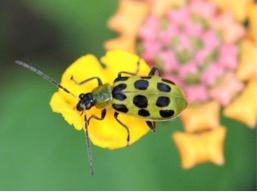Cucumber Beetle
-
AboutCommon vegetable garden pest that also attacks ripening stone fruit. Adult beetles are shiny with black heads, long antennae, and about one-quarter inch long. Striped or spotted depending on species. Larvae are whitish and slender with three pairs of short legs; the head and tip of the abdomen are darker.
 Photo: John Flannery/Wikimedia Commons
Photo: John Flannery/Wikimedia Commons -
CategoryInsect
-
Signs/Symptoms
Adults feed on leaves and flowers of many vegetables as well as on soft fruit. Larvae eat the roots. They carry cucumber mosaic and bacterial wilt, for which there are no cures. If a plant is infected, it should be removed.
-
Where
Beetles overwinter as adults in weedy areas and move into gardens as soon as plants start to come up. They lay their yellow orange eggs at the base of plants or in soil cracks. Hatching larvae burrow into the ground seeking out roots, feed for two to six weeks, pupate, and emerge as adult beetles that attack the above ground portions of the plant. There are several generations a year.
-
When
As soon as plants start to grow.
-
Prevent
The best way to deter the beetles is with row covers. Place the covers on newly planted cucumbers or seedlings and remove them when the plants start flowering. On stone fruit trees, early harvest may be the only option.
-
Manage
Management of cucumber beetles is difficult. Most older plants can support substantial numbers without serious damage.
Picking the beetles when populations are high is not effective. But if you choose this control method, hunt for them early in the morning when they are slower.
Some of the natural predators include beneficial insects like braconid wasps, some nematodes, and soldier beetles.
-
More Information

